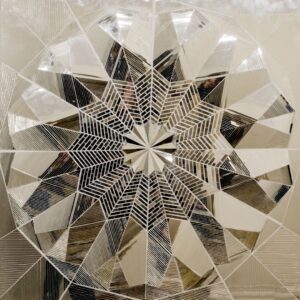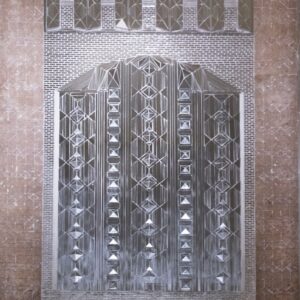The Azure Dome
Solo Exhibition By Tania Assl29 November to 20 December 2019Tania Assl was born in Tehran in 1984 and has a BA in Animation from the Tehran College of Broadcasting. She is also a painter and has worked professionally as a graphic designer. Tania exhibited her interest in architecture and geometry in her first solo show Gonbad-e Kabud (The Blue Dome). About this exhibition, Tania says, “Iranian architecture with its interior spaces and gardens can be viewed and interpreted from different angles. In this project, my intent was to view this type of Iranian architecture from various angles and multiple perspectives as is found in the Herat style. Parts of a coherent whole that not only retain the consensus, centrality, discipline and coherence, but also each small segment that has the coherence of the whole unit; a sacred geometry, a self-constructing autonomous geometry; a never-ending repetition that arrives at a whole.
Tania uses glass, mirrors and soil as her materials for this collection. The use of mirrors is to emphasize the representation, but by using small geometrically-shaped pieces of mirror, the representation is altered. In fact, the goal of using mirrors in an architectural setting was not just to be visible but to show the magnificence and greatness, since preserving the large scale was of import to the artist. However, ‘glass’ stands opposite to the ‘mirror’ and creates a type of balance. The transparent glass allows for the foundation beneath to be seen, in this case, ‘Soil’.
Tania Assl was born in Tehran in 1984 and has a BA in Filmmaking from the Iran University of Broadcasting. Prior to her studies, she was active as a painter and also worked professionally as a graphic designer.
“Hoorno” is Tania’s second collaboration with INJA Gallery. In traditional Iranian architecture, ‘hoorno’ is defined as lighting provided through the ceiling. This series consists of seven works, all designed and created with this concept as their central theme.
Her last exhibition, “The Azure Dome”, was held in 2019. In continuing with the theme of domes, she has created “Hoorno”, now focusing on shadows more than light itself.








